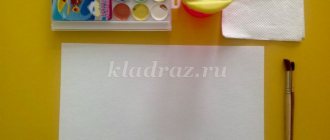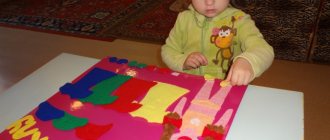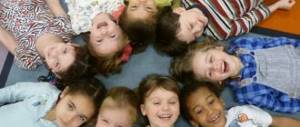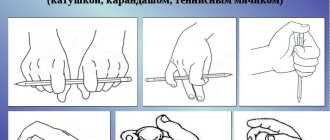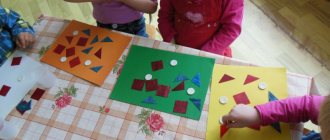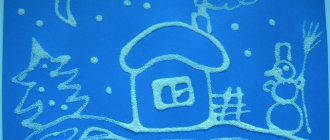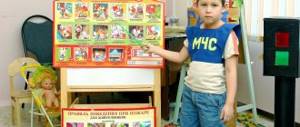Lesson summary 2 junior drawing group “Hedgehog”
Summary of a lesson in visual arts in the first junior group on the topic: “Here comes the hedgehog - no head, no legs!”
Software tasks:
Teach children to create collective work in collaboration with the teacher and other children: draw needles - straight vertical lines, complementing the image of a hedgehog created by the teacher.
Learn to observe the teacher’s creative work and act by imitation.
Create a desire for berries and apples with foam rubber pokes or fingers and print leaves with your palms.
Develop a sense of color and fine motor skills.
Cultivate curiosity.
Preliminary work
:
- drawing legs of a centipede in collaboration with the teacher and other children;
- looking at pictures and photographs of a hedgehog.
Materials and tools, equipment
:
A sheet of blue paper measuring at least 60-70 cm, the silhouette of a hedgehog, pre-cut from light gray (beige) paper; colored pencils, felt-tip pens, parallel pointers and gouache paints for drawing berries, apples and printing leaves; paste, napkins, oilcloth.
Contents of the lesson.
The teacher shows the children a toy hedgehog and reads an excerpt from G. Lagzdyn’s poem “Hedgehog”:
I met a hedgehog
He carried the mushrooms on his back.
- Good afternoon, prickly hedgehog!
How far do you live?..
The teacher involves the children in the finger game “Spiky Hedgehog”. The kids raise their hands up, at the teacher’s signal, spread their fingers, clench them into fists and open them again - “the hedgehog hides and shows his spines.”
Then the teacher shows the children a silhouette of a hedgehog, cut out of light gray or beige paper, and invites everyone to draw many, many needles together. He puts a sheet of paper on the table, glues the silhouette of a hedgehog, takes a felt-tip pen or marker and involves the children in co-creation.
Teacher.
- It's a hedgehog! Where is the hedgehog's back? Here! Needles grow on the hedgehog's back. Where are they? In a centipede, the legs grow on the tummy - downwards (shows the picture). And a hedgehog’s needles grow on its back – upwards!
- Here is the back, I put a pencil here and first draw one needle - like this (draws a line 5-7 cm long), then next to another - like this (fixes the movement so that the children notice the pencil being lifted from the paper, moving it to another place and repeat movement).
Teacher.
— The hedgehog has many, many needles on its back! Let's draw some more!
Practical work for children
.
The children begin to draw. The teacher helps with the “hand in hand” technique. Pointing and outlining gestures (“here”, “here”, “like this”), explanations, questions (where is the hedgehog’s back, where do the needles “grow” from?).
Teacher.
— The hedgehog turned out wonderful, he hurries to his home and carries apples. (the teacher takes the pokes, dips them in gouache and uses the poking method to depict apples and berries).
- Guys, take the pokes, draw apples on the needles (he comments on the children’s work “many, many apples and all of different colors”).
Children draw.
— Our hedgehog walks along paths with colorful leaves. Look at what beautiful leaves you can make using your palm (take a child’s palm, apply multi-colored gouache with a soft brush and help apply the image of a “leaf” to the paper). Invites children to draw a beautiful path using the “palm typing” technique.
Children draw.
Teacher.
- Well done boys! Let's go wash our hands while the paint on our work dries.
They wash their hands and return to the easel with their work.
They examine the result of their work and show it to the guests and go for a walk.
Drawing techniques for children of the second younger group
There are quite a few types and techniques of drawing available to children aged 3–4 years. Below are the most interesting and useful of them.
Finger drawing
This simple and fun technique is ideal for introducing fine art. It is quite simple to implement, gives the child freedom of action and is easy to master in a playful way. For the first time, you can try leaving fingerprints on paper using different colors. Once the child understands the meaning of this action, you can allow him to draw with his fingers at his own discretion.
Important! The teacher must first demonstrate this method himself. After the child has shown interest, he is invited to do the same. If the baby does not demonstrate readiness, the lesson should be postponed.
Once this technique is mastered, you can use it to create narrative drawings. To do this, before class, outline images of the sun, a balloon, a house or other objects are drawn on sheets of paper with a marker. Then the children are asked to use their fingerprints to fill the space inside the finished drawing.
Drawing with palms and fists
Once the finger technique is mastered, children can easily move on to drawing with their palms. An adult needs to be creative and think through the plot of the drawing in advance. The handprint can be the rays of the sun, some animal, flower, tree or house. After the paint on the paper has dried, eyes, ears, leaves or other elements that make the drawing recognizable are drawn in with felt-tip pens.
Drawing with palms
Drawing with stamps and signets
Drawing stamps can be purchased at art stores or made independently from natural materials, cardboard, foam sponge, cotton swabs, even potatoes or cauliflower. This technique makes a special impression on children due to its simplicity of execution and spectacular results. At the first stage, you can let children master the use of a stamp in a free form, and then offer a plot drawing.
Stamps
Blotography
This method will introduce the child to the properties of paints. Applying watery blots and streaks to the paper will reveal an interesting mixture of colors. At this moment, you can draw the child’s attention to the fact that two different colors, when mixed, can give a third, completely new one. You can also experiment with thickness - apply streaks and splashes first with liquid and then with thicker paint. After the drawing has dried, using felt-tip pens or pencils, you can shape the blots into an image of space, landscape, season (for example, if yellow and red colors predominate - autumn, blue and white - winter).
Blotography
Monotype
An effective technique that creates symmetrical patterns. A sheet of paper is folded in half and paint is applied to one half in the form of blots, or, if the plot is thought out in advance, along the contour outlined in pencil. Then the paper is folded, smoothed with the palm of your hand and straightened. The resulting print is allowed to dry, after which the necessary contours and elements are drawn in with felt-tip pens. It is so easy to depict objects such as a butterfly, an airplane, a book.
Monotype
Dots and lines
For this type of drawing with children 2–4 years old, use pencils or wax crayons. Mastering dots and lines will prepare the child to build more complex compositions from them on a sheet of paper. You can pay attention to different types of lines - straight, wavy, zigzag, and then use them to depict sea waves, hills, mountains on paper. Using the dots in the picture, you can try to depict rain, snow, flowers, sand. In this way, the child is introduced to the landscape and asked to depict spring or winter using simple lines and dots.
Waves
Tracing and painting
Children are given or offered a choice of templates in the form of pets, toys, dishes, and vehicles. The templates are outlined and painted over with paints or pencils.
Card index of games for artistic and aesthetic development
To conduct the lesson you will need the following materials:
- The basis for drawing is paper, cardboard for making small drawings; For finger painting or drawing with your palms, it is convenient to use whatman paper or the back of the wallpaper.
- Colored pencils, markers, crayons, gouache, watercolors, brushes, sippy cups with water.
- Stamps, seals, homemade stamps from scrap materials.
- Oilcloths, sponges, wet wipes, aprons, rags, soap.
Drawing in the younger group requires an individual approach to each student. This is a new and difficult activity for the child, in mastering which he needs constant support and assistance from the teacher. Any criticism should be avoided, regardless of whether the desired result is achieved. At each stage of the lesson, it is necessary to pay attention to each child and help to cope with the difficulties that arise.
Important! At the age of 3–4 years, children can already understand and follow short, understandable instructions, so the introductory and demonstration part of the lesson is conducted by the teacher for the whole group.
GCD for drawing in the second junior group on the topic “Cockerel - golden comb”
Goal: To become familiar with the “Drawing with Palms” technique.
Tasks:
- Learn how to make a palm print on a piece of paper.
- Develop paper orientation.
- Develop creative skills.
- Cultivate a love for animals and empathy for the character.
Demonstration materials:
- illustrations for the fairy tale “The Cockerel is the Golden Comb”;
- audio recording of a fairy tale.
Handouts: gouache, brushes, sponges, napkins, cotton swabs, sippy cups with water, paper, oilcloths, aprons.
Preliminary work:
- listening to an audio recording of the Russian folk tale “Cockerel - the Golden Comb”;
- solving riddles about the cockerel.
| List of professions | Regulatory issuance procedure |
| Builders | signal form; gloves; PPE for face and ears; Vibration reduction products |
| Drivers | mittens; warm suit; safety shoes |
| Loaders | overalls; gloves; jackets; trousers. |
| Sales staff | headscarves; gloves; robes |
| Agricultural employees | gloves; shoes; mittens. |
| Electrical workers | dielectric special gloves; safety shoes; headdress; outerwear; thermal underwear for dielectrics. |
Mathematics classes for preschoolers aged 6-7 years
Cockerel
Cockerel
Cockerel
Instructions for making the drawing “Cockerel - golden comb” using the palm painting technique:
- A sheet of paper is placed horizontally in front of the child.
- Using a sponge, the central part of the palm and thumb are painted yellow.
- The remaining fingers are colored red, green, blue and orange.
- The hand should be held in front of you with the thumb up, and the remaining fingers spread wide.
- The palm is pressed firmly onto the paper.
- Use napkins to wipe off the remaining paint from your palms.
- A cotton swab is dipped in black paint and placed in the middle of the thumbprint - this is the eye of the cockerel.
- The clean end of a cotton swab is dipped in red paint and a beard and comb are drawn with a poke.
- The beak is painted on with a thin brush.
- If desired, the drawing is complemented by other elements - sun, grass, roost for a cockerel.
Important! The leading activity of children aged 3–4 years is play, so it is advisable to include it in drawing classes in the 2 ml group.
Card index of games for children 3 years old
A card index of games has been developed for children aged 3 years during drawing classes in kindergarten.
Game "Magic Colors"
Goal: to introduce children to the features of color mixing.
Materials: colored cards, “+”, “-”, “=” cards.
Move: an example is shown, made up of cards: red + blue = purple; green+red=brown.
Children solve them using paints on paper.
Game "Aquarium"
Goal: learn the names of colors.
Material: fish made of cardboard of various colors, cards - aquariums with outline drawings of fish in the corresponding colors.
Progress: according to the teacher’s instructions, children select fish to the contours in the aquarium.
Game "Matryoshka"
Goal: to consolidate knowledge about the main styles of Russian painting.
Move: there are images of nesting dolls on the board. Children take turns trying on their version of a painted sundress.
Game "Duck and Ducklings"
Goal: improve spatial orientation skills.
Materials: cardboard ducks and ducklings, image of a pond.
Progress: the children are given the task of making the path of the duck to the ducklings, and then to the pond.
Game "Winter Fun"
Goal: consolidate knowledge about winter.
Materials: image of a winter landscape, templates for winter clothes and shoes, winter games items.
Progress: with the help of a winter landscape, the teacher updates knowledge about winter. Children are invited to choose from templates items related to winter and winter games: felt boots, mittens, hats, sleds, skates, hockey sticks.
